It’s only natural to trust the word of friends who recommend a business more than any ads you see for the same company. Studies have shown that 84% of customers trust personal recommendations from people they know more than any advertising that comes from a brand. That’s why referral marketing is one of the best ways to generate leads and multiply your customer base. Plus, these recommendations mean free promotion for your business.
But without a referral marketing strategy, customers may forget to share your brand with friends, meaning referrals can be unpredictable and infrequent. How do you create an engine where customers keep generating valuable word-of-mouth?
Referral marketing is all about encouraging your customers to share your business with friends – repeatedly.
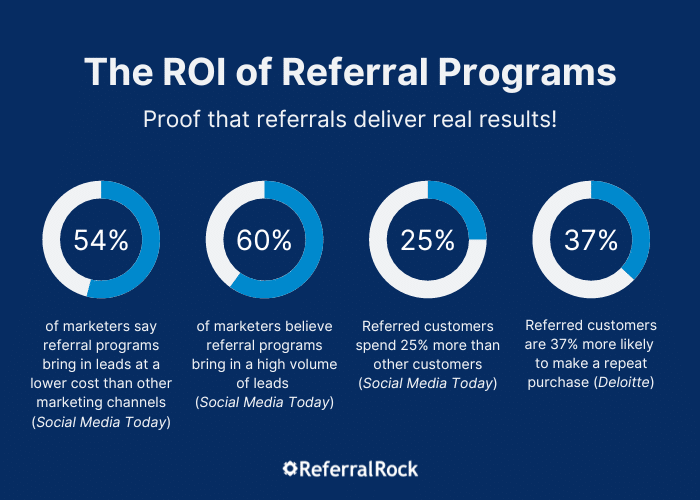
This guide will cover everything you need to know about referral marketing: key fundamentals, best practices, and examples from top brands (with takeaways for your own referral marketing strategy).
What is referral marketing?
Referral marketing is a word-of-mouth strategy that encourages existing customers (and other fans) to promote you, by rewarding them when they share your brand with potential new customers. It turns people into reliable advocates for your brand, who keep promoting you through word-of-mouth recommendations.
How does referral marketing work?
Referral marketing gets your customers and fans to reliably recommend you, by giving them a valuable incentive whenever they refer new business. Usually, you’ll also give the friend an incentive when they become a new customer, to encourage them to take that leap. It’s a win-win-win!
Referral marketing is powerful because it leverages the trust people place in their friends to generate new leads and customers.
The best way to mobilize referrals is starting a referral program where the rewards are standardized and where it’s easy to share with just a click or tap.
Here’s why you need referral marketing
The main purpose of referral marketing is to actively encourage existing customers to bring in new customers through word of mouth.
Whether in person or online, people want to share what they love with their friends. And referrals from peers are highly trusted.
But if you aren’t doing anything to motivate and mobilize referrals, you’re likely missing out on revenue.
This means many customers forget to tell their friends about you, even though they love your brand and the experience you’ve given them.
Even if people are satisfied with your business and willing to share your brand organically, they might not think about referring friends without a reminder.
Referral marketing creates this reminder in the form of a reward — it maximizes organic word of mouth and incentivizes customers to refer even more people. It keeps you on top of your customers’ minds, builds longer-term relationships with your most loyal customers, and creates a healthy base of new customers. All this, at little to no cost to your business.
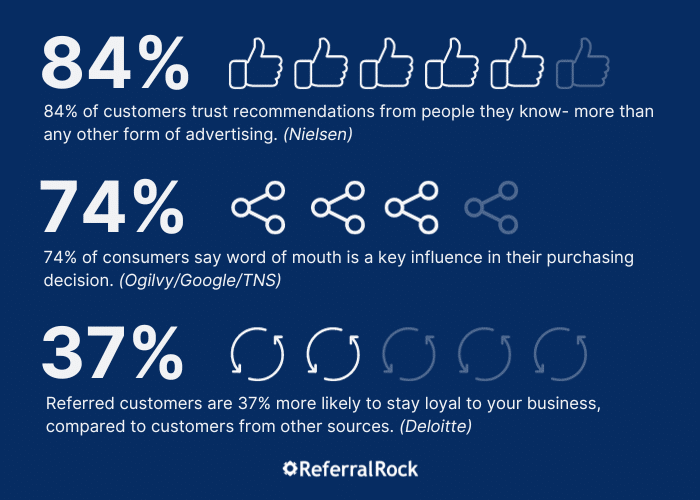
Note: Referral marketing is different from affiliate marketing. Referral campaigns encourage customers to recommend your business to people they know. But in affiliate programs, content creators recommend a brand to their audience, most of whom they don’t know personally.
Why does referral marketing work?
A referral marketing program gives you a structured and sustainable flow of attracting new customers.
When everything comes together – your customers are happy, your incentives are attractive, and your program is well-promoted – your referral marketing strategy is primed for success.
- 74% of customers say referrals have influenced purchase decisions.
- And word-of-mouth referrals are estimated to drive 3x-5x more results than paid ad channels.
Companies like Dropbox, Uber, Tesla and PayPal have all achieved significant results with a referral marketing strategy. Their success is proof that a strong referral marketing system can strengthen existing customer relationships, bring in new leads, and grow your business through trusted recommendations.
What are the benefits of referral marketing?
We may be a little biased, but the benefits of referral marketing are incredible. While it usually takes some time, building relationships and trust with your existing customer base is well worth the wait.
Here are the main reasons why you should leverage referral marketing:
1. Empowers word of mouth
Referral marketing enables scalable word of mouth to happen. Because you are encouraging your biggest brand advocates to recommend you to others, a referral marketing campaign puts you in front of a large pool of people you might not otherwise have access to.
With an automated referral and reward system in place, you’re able to turn word-of-mouth marketing into a channel and generate even more brand awareness.
2. Builds social proof
People choose their actions based on others’ opinions more often than you realize. What products to use, where to shop, what to eat, and even what shows to watch on TV – these are all questions people answer by looking at others.
And if everyone’s gravitating toward a particular brand, people will naturally assume it’s the right brand for them too. Referrals are one of the building blocks of social proof. They help prime potential customers, which leads to faster purchases and higher conversion rates based on trust.
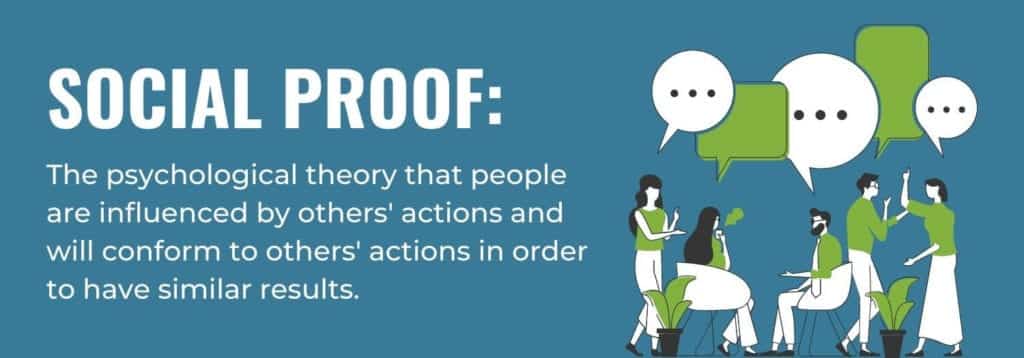
3. Uses social currency
People are always willing to share something that will make them look good or cool – they’re willing to “spend” their social currency on a brand, product, or content piece if they think it will boost their reputation.
They will only use their social currency to recommend brands they think others will also like. So, if they recommend you, this already places your brand in a good light (it’s safe to say a person wouldn’t spend their social currency on a brand that makes them look bad.)
And since your brand is being recommended by a trusted source (someone they already know), referral marketing works to build both your brand and their social currency.
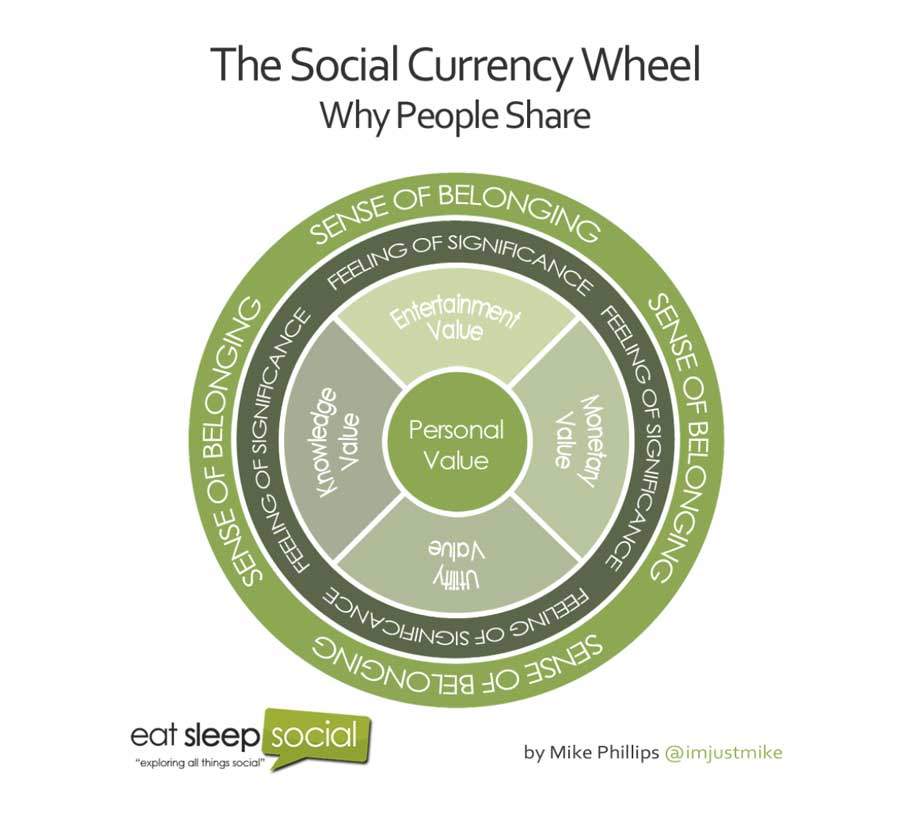
4. Grows a targeted audience
Referral marketing creates high-quality and targeted leads. No one is going to refer every single one of their friends to you – they’ll only refer those who actually need or may be interested in your product. Even if someone shares their referral link on social media, only the interested friends will click to learn more.
This means referral marketing involves a natural filter. Your current customers share your brand to their friends and family members, already filtering the people they think would benefit from your products and services.
Only the people most likely to become customers are referred to your business. And because these new referrals hear about you from a source they trust, they’re more inclined to give your brand a try.
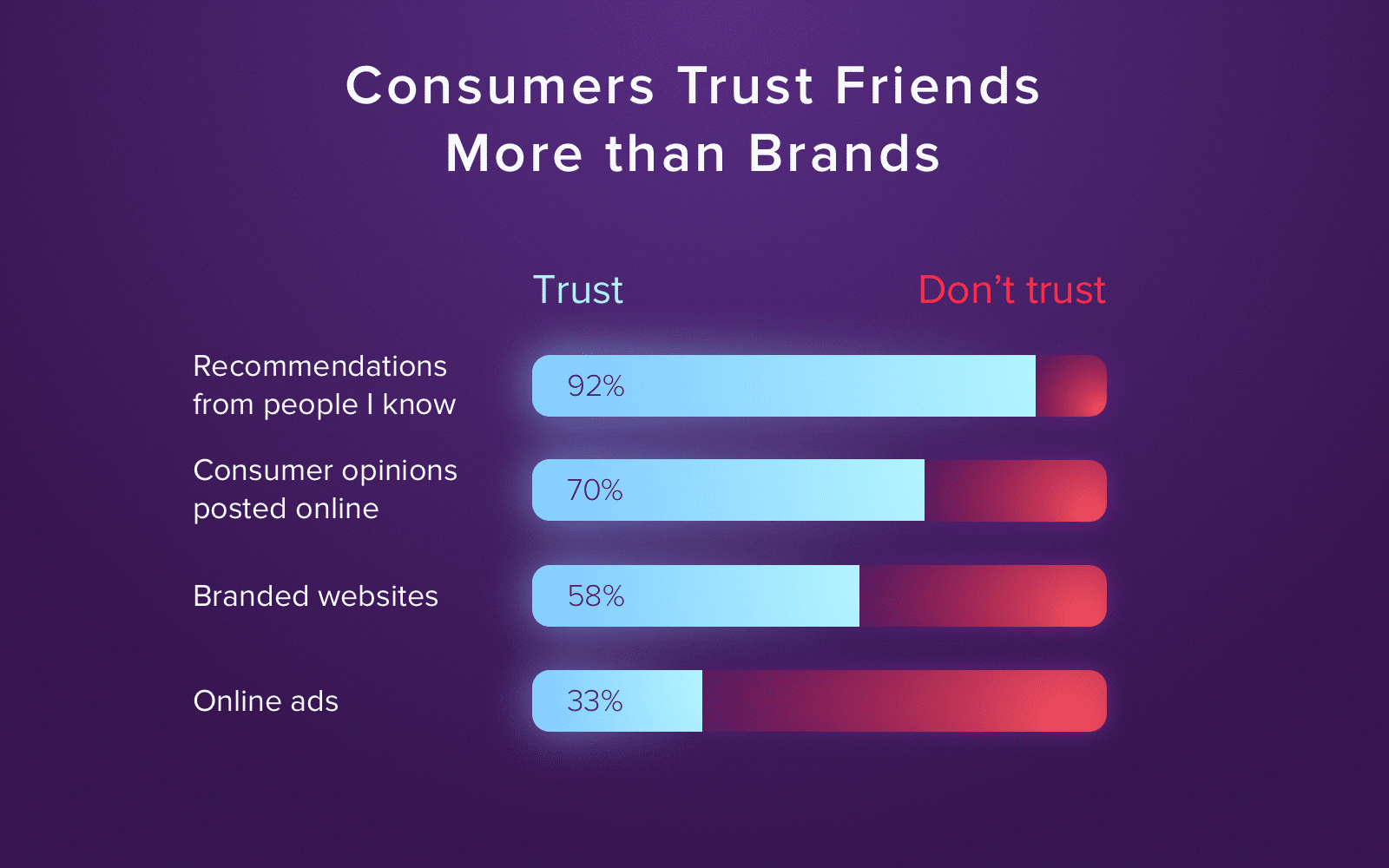
5. Increases loyal customers
Referrals who turn into new customers often end up becoming some of your most loyal advocates. From the first time they hear of you (from a friend), you’re already placed in a good light. And if you offer dual-sided rewards – meaning the new customer gets a reward, too – the odds of them being a satisfied customer are continuing to stack in your favor.
The stronger customer loyalty of referred customers means that these customers have a higher overall customer retention rate, and a higher lifetime value – 16% higher than that of other customers.
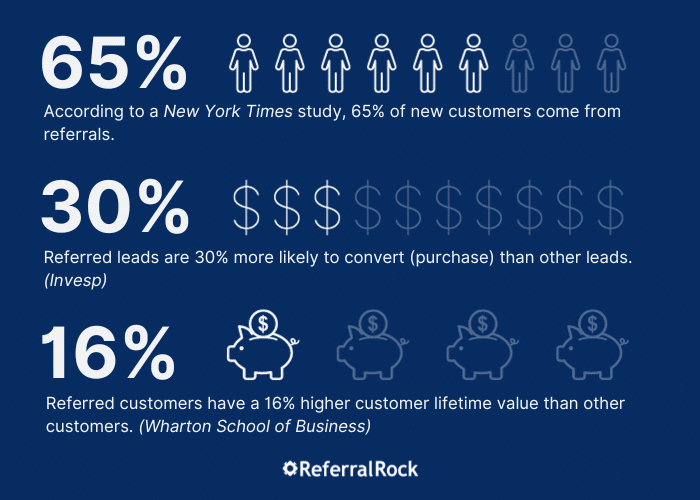
Note: Referral marketing encourages customer loyalty, but a referral program is different from (and better than) a loyalty program. While loyalty programs only reward customers for sticking with you, referral programs reward people for bringing in new business and create a base of both loyal new and existing customers.
6. Extends your business reach through a paid, owned, and earned media channel
A referral marketing program is owned media, which makes it an authentic channel to interact and engage with your customers.
Not only is it a marketing channel you have complete control over, your referral program allows you to scale quickly because every new customer can lead to multiple sales.
Referrals are also earned media at their roots, as your customers choose to promote you. And when you reward customers for sharing, a referral marketing program counts as paid media, too. Thus, you’ll enjoy the benefits of paid, owned, and earned media.
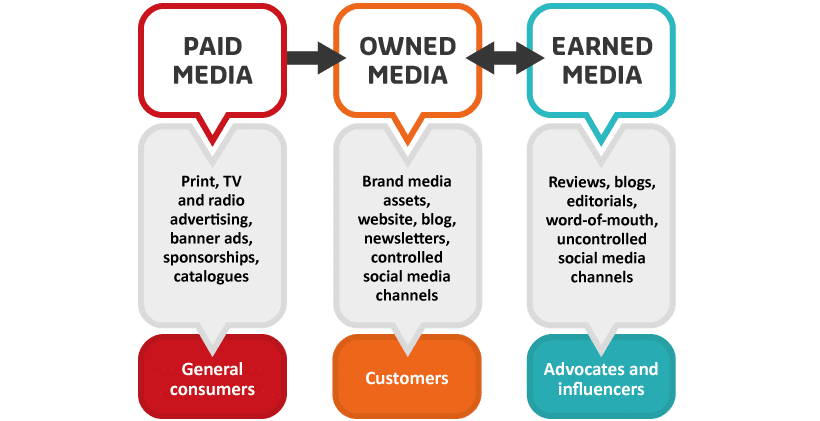
7. Builds a cycle of sharing
One especially powerful feature of referral marketing is that it has the potential to create a cycle of sharing. Previously referred customers are four times more likely to refer their own friends, in part because they want to pay it forward.
In turn, these friends are likely to refer their own peers, possibly kicking off a continuous cycle of sharing.
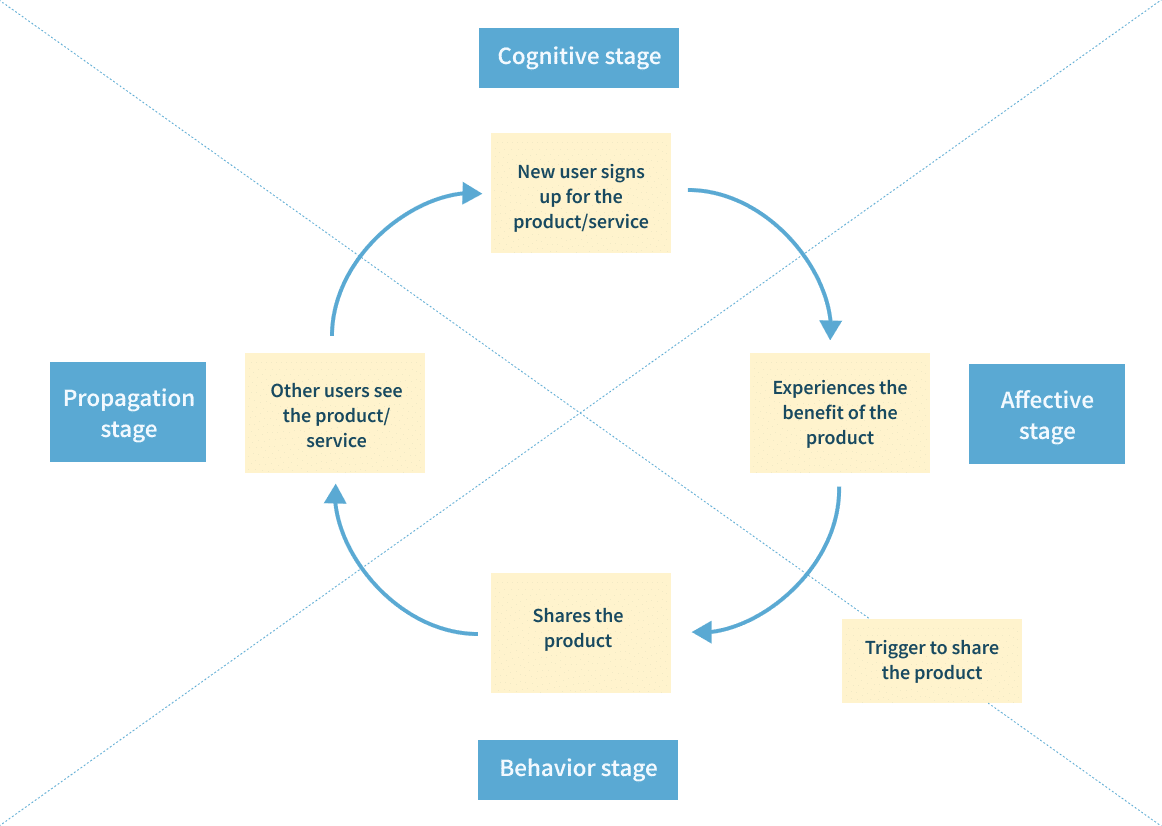
8. Creates a cost-effective marketing strategy
Traditional marketing can take a lot of time and get very expensive. Referral marketing, on the other hand, is an inexpensive way to market your brand and get the word out there relatively quickly. Because you’re inviting existing customers to help promote you, you’re making the most of relationships you’ve already built.
And once your referral program is up and running, it functions as a performance marketing channel (as you only pay when you see results). After the initial setup costs, you only have to pay out rewards when you get a new customer.
13 best referral marketing strategies
While the perfect referral marketing program depends on your business and market, there are a few best practices that can guide the way and optimize your referral experience. Here are the referral marketing strategies we find most valuable:
1. Know when and how to ask for referrals
Referrals don’t just happen on their own. Sure, you can get some organic word of mouth just by providing great products or services. But for a steady source you can rely on, you’ll need to ask for referrals.
Ask when customers are happiest with your products or services and you’re already top-of-mind, such as when:
- A customer has recently left a positive review or raved about you on social media (you know they’re willing to share you publicly).
- Right after checkout, especially after a repeat purchase or a renewal (take advantage of your thank you page or transactional emails to promote sharing).
- They’ve given you direct positive feedback (say, in person, via email, or on a Zoom call).
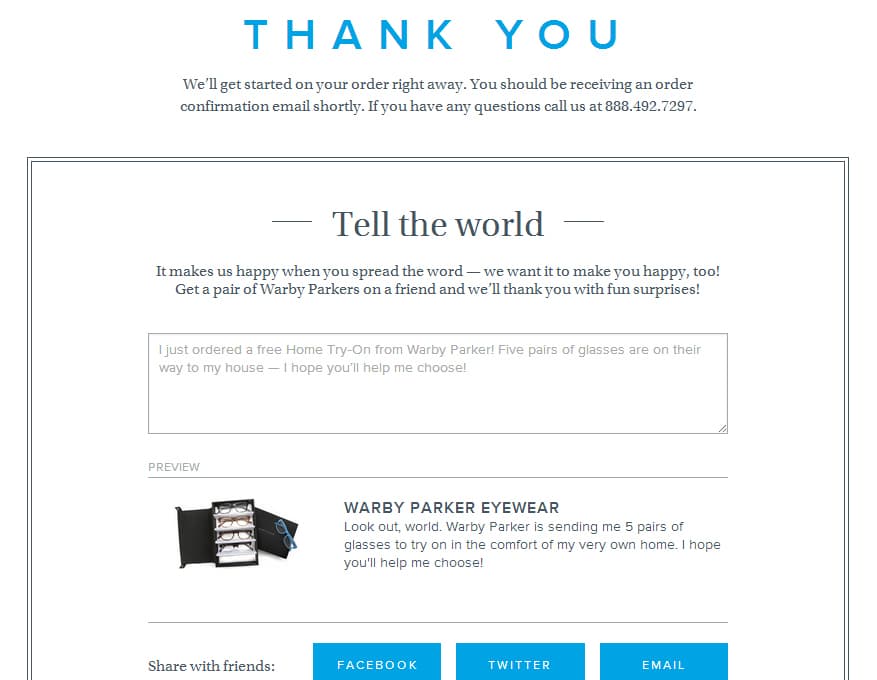
2. Go beyond customer expectations
Referral marketing relies on happy customers. Most customers have come to expect good products and friendly customer service. To really stand out, you have to find ways to exceed your customers’ expectations. For example, you can send a surprise gift on their birthday, upgrade their plan for a month, or perform an act of kindness in a time of need. These small tokens of appreciation are a great way to make your customers happy and encourage them to refer their friends.
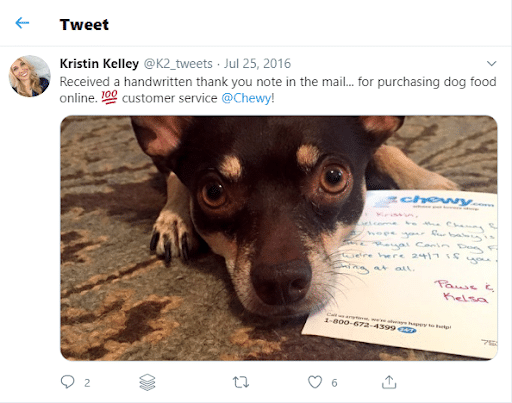
3. Create community around your brand
Creating community is one way to offer value, keep your brand top of mind, and provide customers a reason to share. You can foster community around your brand in several ways:
- Produce compelling social media or blog content that fosters lots of comments and conversation.
- Encourage customers to share user-generated content featuring your products (say, with social media prompts and contests)
- Launch an online group or forum where customers can trade tips for using your products (or where they can suggest different ways your product can be used, like LEGO has done with its LEGO Ideas site)
All of this will increase customers’ investment in your brand – and encourage them to invite friends to join the community.
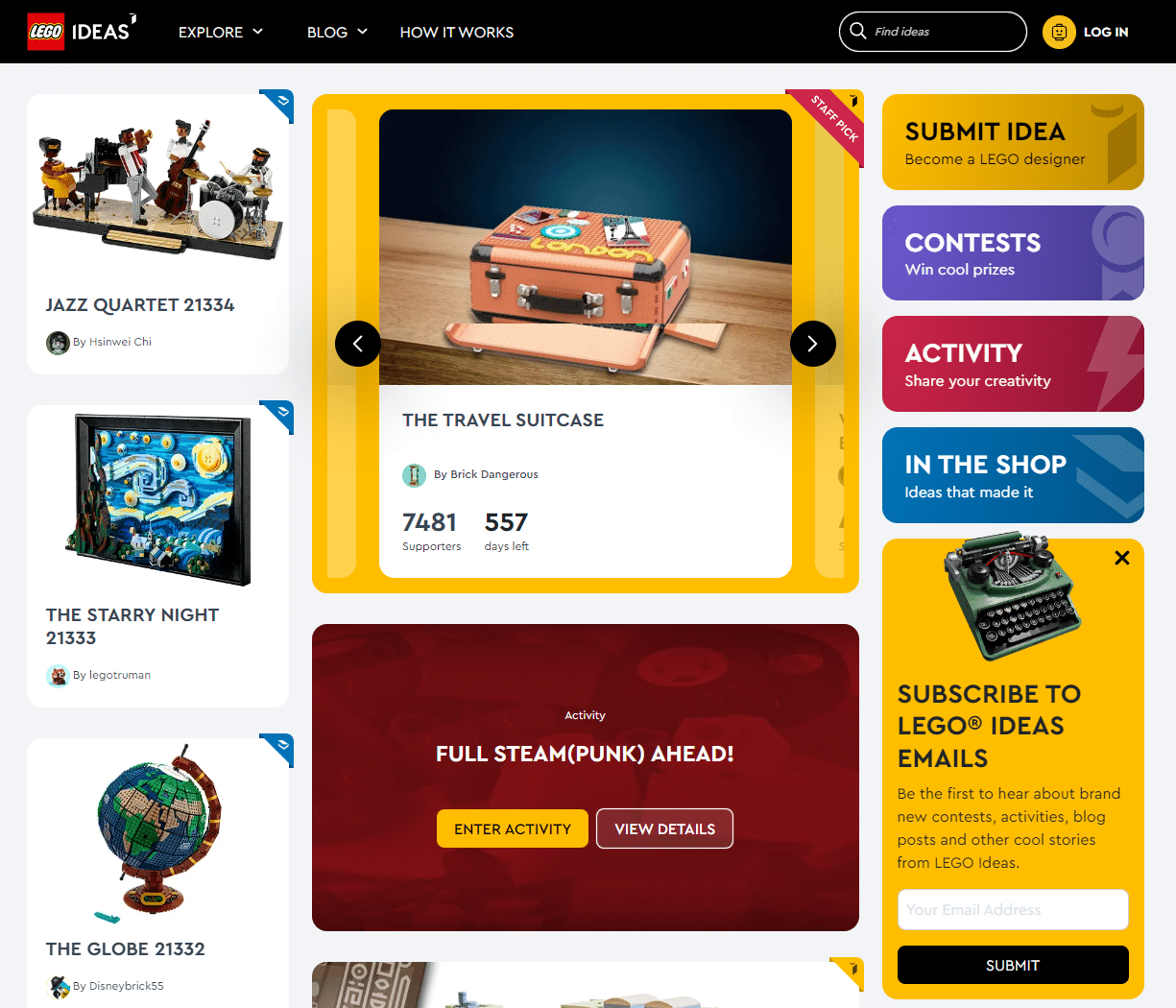
4. Offer strategic sharer incentives
Even if customers like your brand, that might not be enough for them to actively refer others. What might help? A referral incentive can do the trick and get people talking. And the incentive doesn’t have to cost a lot – or be paid in cash.
You can offer free early access to your new products, an exclusive invite to your next webinar, store credits for a future purchase, or discount coupons.
Or, you could offer some branded swag, as newsletter The Hustle does – they bought their referral program swag in bulk, so it’s especially cost-effective. Content and experiences can also work for rewards, if they feel exclusive enough. With a little creativity, you’ll find the perfect reward that fits your budget and your business.
| If… | Then… | And offer… |
| Referrers purchase frequently | Tie the rewards back to your business | Store credits, discounts, or free products |
| Referrers aren’t likely to purchase in the near future | Don’t connect the sharer reward to your business | Cash, gift cards to other businesses, or tangible rewards |
| You operate on a subscription model | Encourage continued subscription renewals | Discounts on subscriptions, a free month, or upgrades. |
5. Reward the friend being referred, too
It’s best if sharers and their friends will get rewarded, in what’s called a double-sided referral scheme (or give-and-get structure).
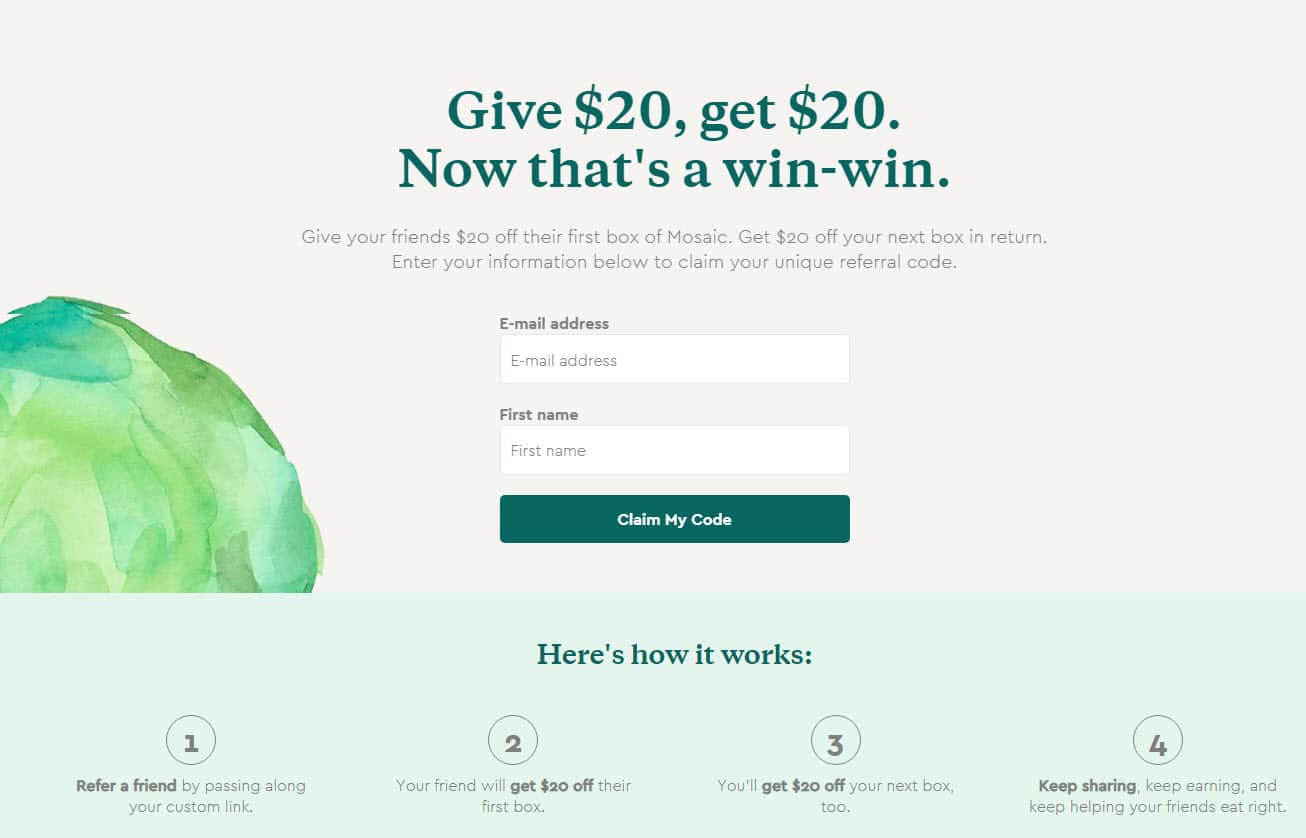
Customers will be much more motivated to refer if they get something for themselves and can give something for their friends. That way, they won’t feel like they have to “sell out” their friends just to get a reward, but can instead help their friends out in more ways than one. Plus, rewarding the referred friend further encourages them to make their first purchase. That’s definitely a win-win-win!
6. Tap into social media
We live in a social media crazy world.
- The average internet user spends up to 145 minutes on social media every day – that’s almost two and a half hours of daily browsing and sharing.
- And a study by Nielsen reveals that 60% of people learn about a specific brand or retailer from a social networking site.
Why not use this to your advantage? Many referral marketing campaigns are shared on social media every single day, and these posts reach many sets of eyes all at once. If you make it easy for existing customers to share your brand on social media, you can increase your chances of being seen by potential customers.
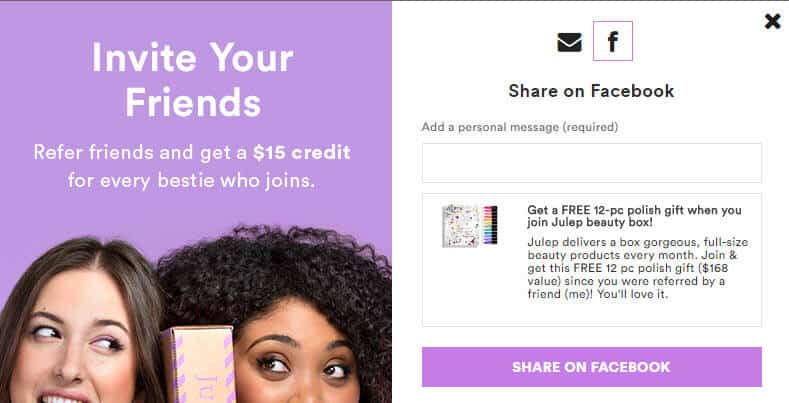
Plus, if someone sees a referral post and is interested, they may share with their own friends, possibly kicking off a cycle of viral sharing.
Choose the platforms your customers are already on. If they’re on Facebook, provide a Facebook option. And if you’re a B2B, encourage LinkedIn referrals.
7. Use email marketing to promote referrals
Email is a little more personal and reliable than social media. It goes straight to the recipient. So, sending out emails is an effective practice to promote your referral program and its rewards, and entice existing customers to share.
We recommend sending out monthly or quarterly emails completely focused on your referral program, to keep it top of mind. This way, people won’t forget about your program.
But referral marketing also fits right into your other existing marketing campaigns. A quick referral message can easily be added into any emails you’re already sending out. One or two sentences is all you need.
For example, you can add a referral link to a customer’s thank you email (confirmation email), or place a small banner in your next company newsletter. You could also ask for referrals when you ask for reviews, like mattress company Casper did.
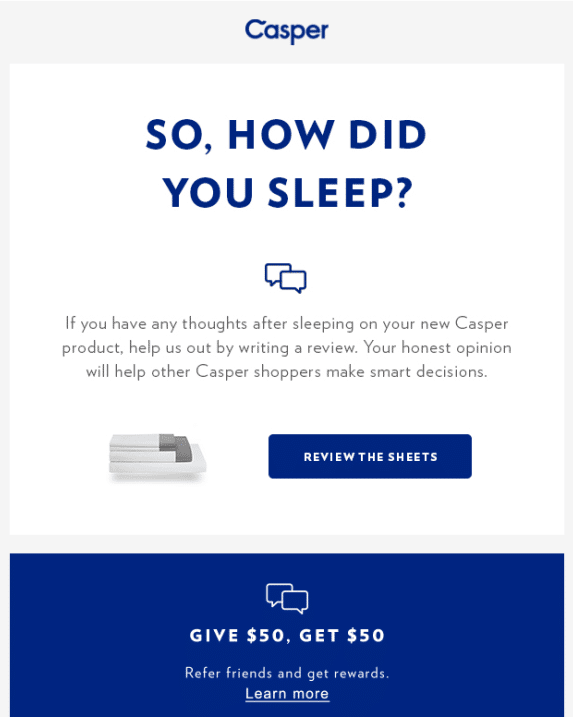
A quick link in your email signature or a simple CTA at the bottom of your newsletter can also work really well as a form of referral messaging. It helps remind people about your program, without being too over the top.
For more on leveraging email in your referral program, we’ve compiled these resources:
- Learn how to design a referral email
- See some examples on how to ask for referrals via email
- Check out easy-to-use referral email templates
8. Keep promoting your program in other ways
Continuing to promote your program is vital, so people always keep it top of mind. The most common reason referral programs fall flat is a lack of promotion, so don’t make that mistake!
Email is the primary way to promote your program (as we covered in the previous point). But you should also reach out and remind people of your program in the other places you connect with customers.
We recommend:
- Promotions on your homepage
- Links in your top and bottom websitemenus
- Promotions in your customer portal/behind a login
- Flyers or business cards with QR codes (bring offline interest online)
- Social media posts
- Promotions in conversations (train your team to ask at the right times)
- Links in your email signatures and social media bios
9. Make sharing easy
Referral marketing is supposed to be easy. If someone has to complete a huge checklist before they can send a referral (or even to join your program), they likely won’t.
Make things easy for them and integrate referral marketing automation into your program. Make sure that they can share your brand in as few steps as possible. Breaking things down into three steps, like Digital Ocean does, is a great way to show how easy referring can be.
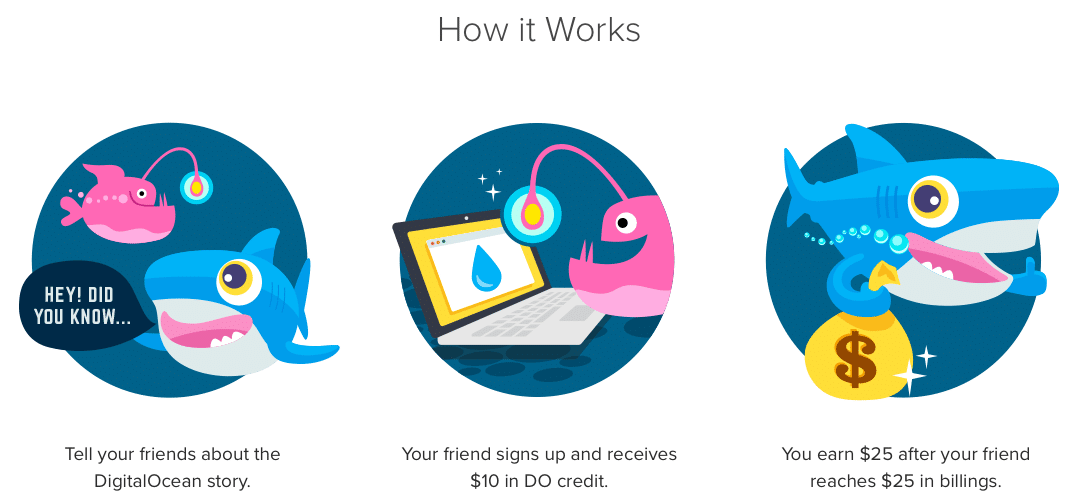
It’s also best to include multiple ways for customers to refer their friends (including via email and social media), like Freshly does.
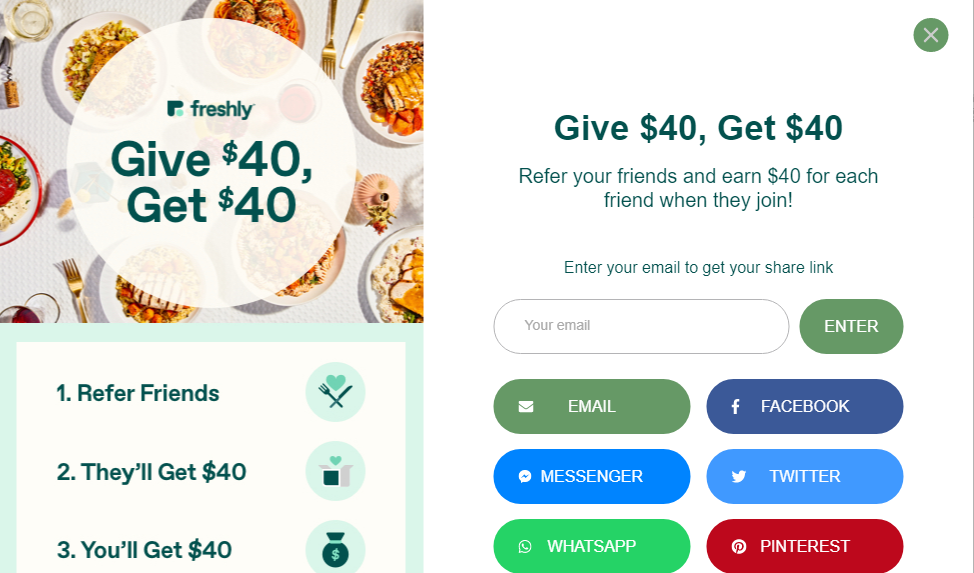
10. Use referral links
Referral links are key to creating a successful referral program.
- They’re a super easy way for customers to send their friends to your website, via any channel, since they can be copied and pasted anywhere.
- You can easily attach rewards for both the referrer and their friend to the link, and activate these rewards when the friend makes their first purchase.
- Plus, referral links are unique to each customer. They trace every referral back to the person who made it, so it’s easy for your brand to see who made the referral and give them the earned reward.
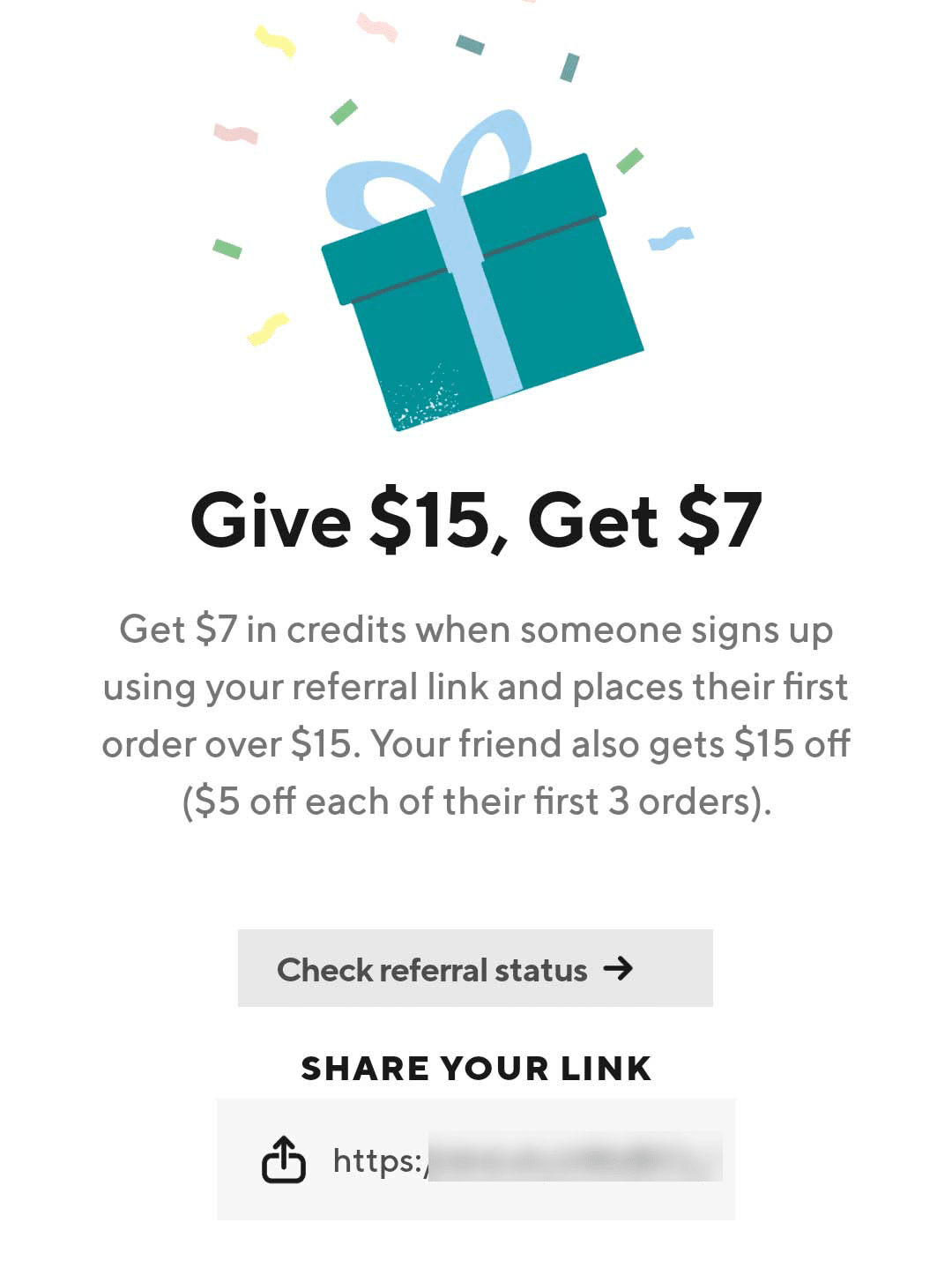
If you use referral marketing software, generating unique, trackable referral links is easy and requires no coding.
11. Create a VIP friend experience
Creating the best sharing experience is vital, but don’t forget about the friend. When people are referred to your business, the message they get from their peers is the first experience they have with your brand.
So, give them a reason to click and learn more, both through the friend reward you show them and the way you present your brand. Build trust by writing the message from the referrer’s perspective.
Then, once they’ve clicked, make them feel like a VIP. Don’t just drop them on a generic page. Instead, remind them of the exclusive offer their peer gave them, and the reasons your business can help them.
Remember, giving out a friend reward is key to getting the most interest from referred leads. What’s in it for them?
12. Consider other types of referral programs
Although customer referral programs are a reliable word of mouth engine, they’re not the only referral marketing program available. You might consider running one alongside other types of referral marketing programs.
- For instance, you might also run an employee referral program, which encourages employees to refer your business to their network.
- Or, you might create an influencer or ambassador program, which trains and mobilizes an exclusive group of customers to share your brand as your representatives.
13. Streamline your referral program with referral software
One of the easiest ways to incorporate all of these best referral marketing strategies is to launch a referral program that you’ve created with referral software.
- Referral software makes it easy to design a trackable referral experience, distribute referral links and instantly issue rewards for successful referrals.
- The right software also automates engagement reminders, so customers are nudged to send more referrals at the right times.
- And thanks to robust data and detailed metrics, you’ll always know how well your referral marketing program is performing, so you can multiply what works and refine the areas that need improvement.
Referral strategies by industry
The type of business you run also plays a role in your referral marketing plan. Here are some detailed bonus strategies tailored for businesses in different industries, to help further increase customer referrals.
You can also check out our resource for more customer referral program ideas for all types of businesses.
Referral marketing for B2C ecommerce
It’s common for B2C ecommerce businesses to use referral marketing and reward programs as a way to increase customer acquisition. Although the incentives for B2C referral programs are relatively low in value (given their lower profit margins), they’re still effective at converting referred leads into customers.
Why does referral marketing work for ecommerce? Most stores sell a wide range of items at a range of different prices. So even if a referral reward is only $5-$10 off the next purchase, it can be worth the effort if the average product is below $50.
Let’s look at a referral marketing example from ColourPop, a B2C company that sells wallet-friendly beauty products.
- ColourPop’s refer-a-friend program is simple to understand and use. Just a few clicks, and customers are ready to share.
- And their “Give 15%, Get 15%” offer works because their products are fairly affordable (a tube of lip gloss is $8 and face powder is $10).
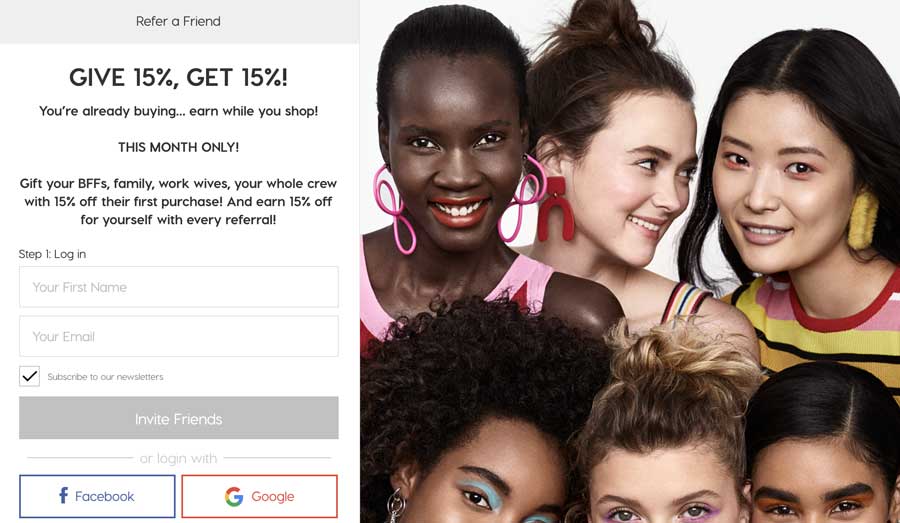
Referral marketing for service businesses
You’ve probably seen your fair share of referral programs for service businesses. (Think of landscapers, HVAC professionals, advisors, fitness trainers, and the like.) This is because most people choose services based on recommendations.
Since service businesses rely on regular customers, it’s common to see referral programs with a tiered reward system or different reward levels.
For example, a personal trainer may give customers $10 for every successful referral. Then, once the customer has made five successful referrals, they might receive a 50% discount on their next session. Or, a landscaping service can offer customers a small reward for every referral who requests a quote. Then, the customer gets another larger reward if the referral ends up as a sale.
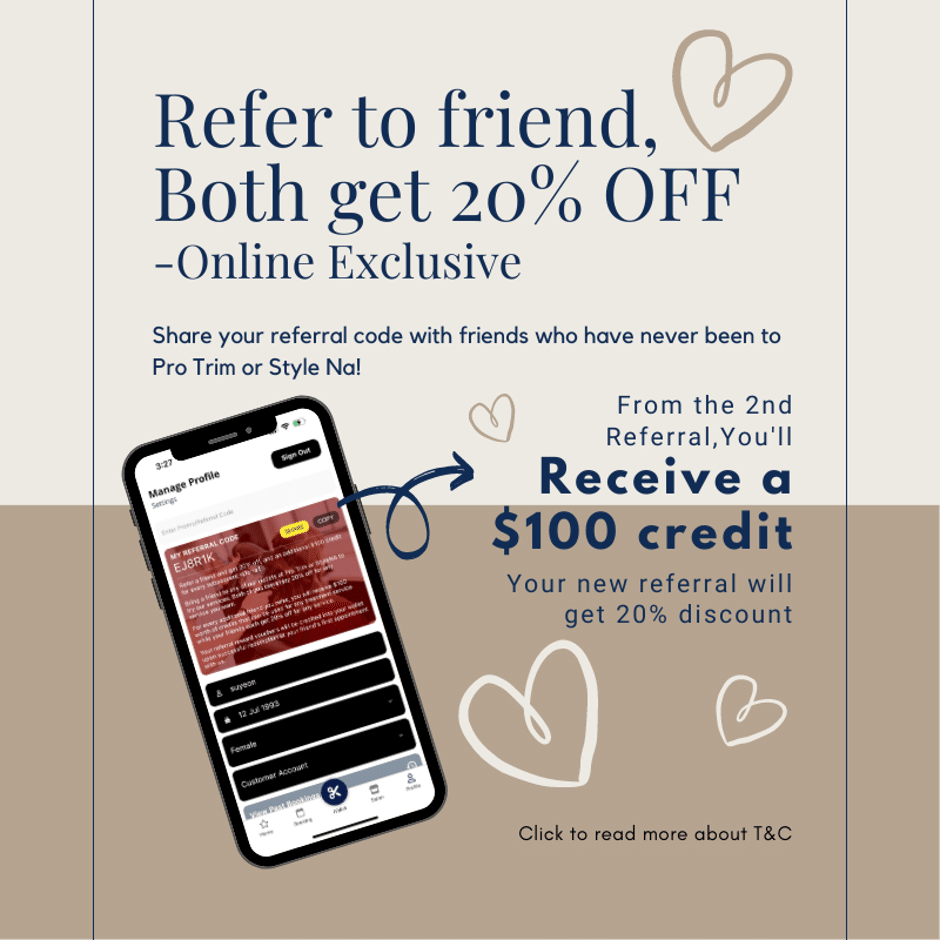
Referral strategies for small businesses and startups
Word of mouth and referral marketing are great ways to grow a small business without going over budget.
Oftentimes, customers will recommend small businesses without any reward. They simply like the owner, product, or service being offered.
But if you want to grow your word of mouth as a channel, consider starting a formal small business referral program so you can show your appreciation to your loyal customers.
Take a cue from Dragon Gym. The gym thanks loyal students for taking classes, and rewards them with money towards tuition when friends they bring in start taking classes themselves. Bring in five friends who start taking classes in the same year, and a student receives an entire year of free membership!
No, you don’t have to use a reward that high in value to incentivize small business customers to make referrals. But directly tying your reward back to your business (like Camp Young Judea also does) works especially well if your business is small.
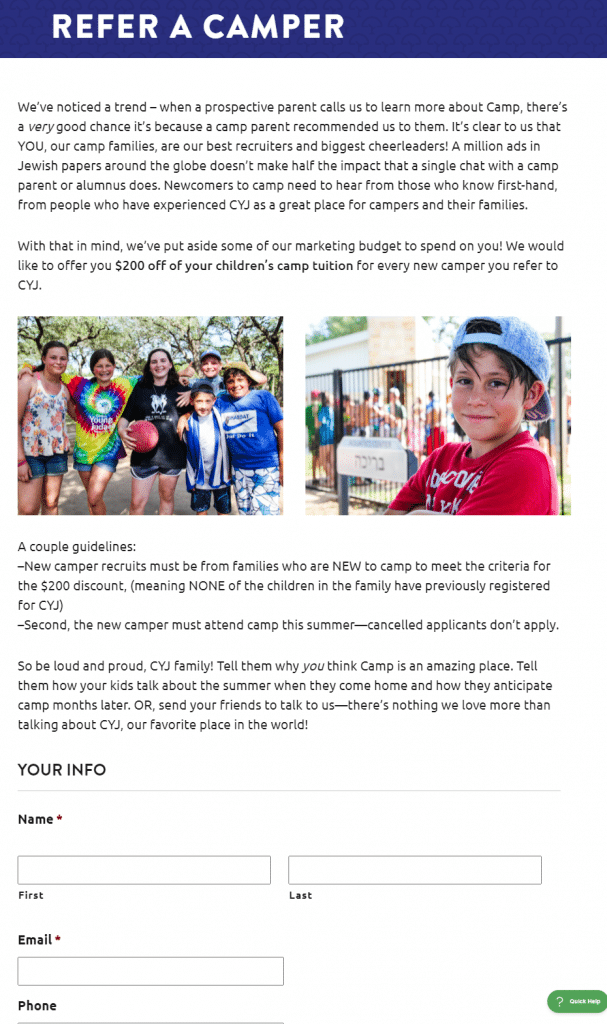
B2B referral marketing strategies
A B2B referral program is usually more structured than other customer referral programs. Not only are B2B sales cycles generally longer than B2C sales, the motivations of a business client are different from individual customers.
For example, offering a discount or store credit won’t appeal to someone if they’re not the ones paying the bill. Cash or gift cards are better-fit rewards in this case. And if your sales process is long, think about giving a smaller reward for leads and a bigger reward for sales, to keep referrers motivated.
Here are some more best practices if you’re planning to run a B2B referral marketing program:
1. Provide an easy way to send referrals
This is important for all referral marketing, but especially for B2B referral programs. Businesses have a job to do – one that doesn’t involve sending referrals to your business. So, keep your referral process as simple as possible. If they have to provide you with a ton of information or perform too many steps, they likely won’t refer at all.
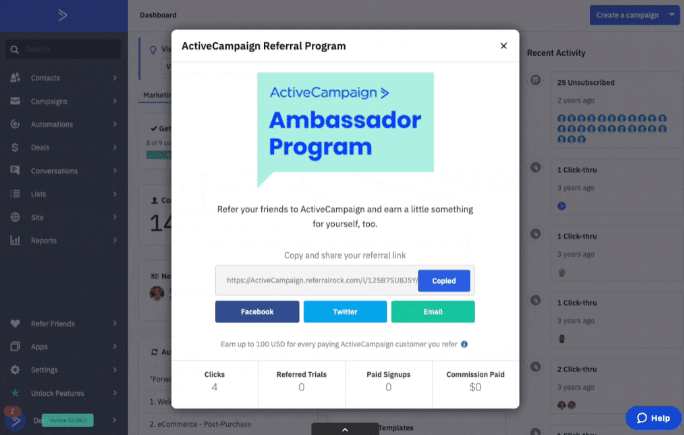
2. Create a clear agreement
If your B2B referral program is a more formal partnership, or your reward will be commission-based referral fees, we recommend drafting a B2B referral agreement. As with all business agreements, it’s important to be clear on all details. The last thing you want is to run a B2B referral program that’s confusing and disorganized. Be sure all referral partner agreements are understood by all parties and mutually beneficial.
3. Make the most of automation
It’s likely that your B2B referral program is just one campaign your business is running. So the more streamlined you can make your program, the more likely you’ll be able to stick with it. Plus, by using trusted referral software or other marketing tools, it won’t be as difficult to track how the program is doing.
4. Update your business website
Most people will research you before getting in touch with your business, even if they are referred. If you don’t have a nice website or landing page, you’re going to miss out on a lot of potential leads and partners. The same thing goes for business websites that don’t look professional or trustworthy.
Referral strategies for SaaS businesses
Whether they’re B2C or B2B, SaaS companies can also benefit greatly from referral marketing. Because they operate fully online, it’s easy to communicate with customers and encourage them to share referral links and codes through email, direct messaging, and social media.
Take Dropbox, for example. Its referral program marketing is one of the main reasons for its global success – 3900% growth in only 15 months!

By leveraging the power of existing users’ referrals, Dropbox doubled its user base every three months.
- Dropbox invited its members to refer others to its cloud storage service using an easy online form.
- Even the referral incentive – more digital storage space – was rewarded in just a few clicks!
- Users could send referral invites in several ways: via email, Facebook, or anywhere else using an easy-to-copy referral link.
- The reward provided clear value for referring (more Dropbox space = a better experience with the product = customers who are more likely to stay loyal to Dropbox).
- Both referrers and newly referred customers received storage space through the program.
- As a result, Dropbox users sent over 2.8 million referrals in a single month (April 2010)!

Of course, the referral marketing reward and form don’t tell the whole story. Dropbox took other actions to help encourage those referrals.
The company kept improving the product based on users’ needs and feedback.
And given the reward on offer, the referral invite came at the perfect time – right after the onboarding, when customers were excited about the product. In other words, Dropbox told customers, “Thank you for trusting us for your cloud storage needs. Here’s a way to get more cloud storage from us for free!”
Plus, Dropbox made it easy for customers to track the progress of their referrals, including by sending notifications whenever a referral earned them more storage space.
Today, 35% of all Dropbox users come from the referral program. That’s over 245 million users from referrals, considering their current user base is over 700 million strong.
Even though your referral marketing program probably won’t cause growth that staggering, you can still take cues from Dropbox if you’re planning on using referral marketing for SaaS – or for any business – and accelerate your growth.
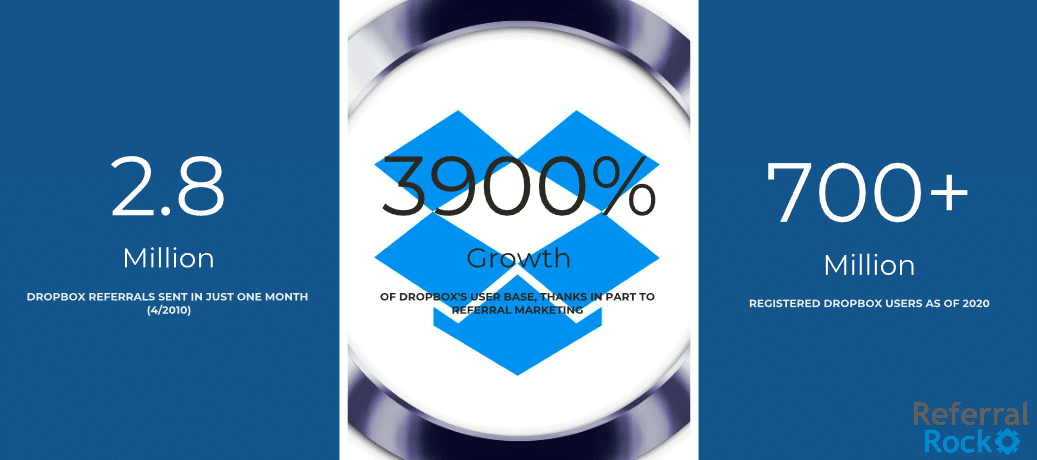
3 more referral marketing examples with real results
Plenty of other brands have seen exceptional results with referral marketing. Even if you don’t see the same results, there’s a lot you can learn from these referral marketing case studies.
1. PayPal
PayPal was one of the first businesses to use a referral marketing strategy, and their program is still going strong. Their program helped them achieve an astounding yearly growth rate of over 1,650%, reach a million users in only two years, and grow to a whopping 100 million users in only six years!

What can you learn from PayPal’s referral marketing?
- Sometimes, you can’t beat the simple, equal referral reward – an amount of credit for the referrer, and the same amount to the referred friend, when the friend receives their first purchase. This is known as a double-sided, reciprocal reward.
- Make your referral program easy to understand, so customers can start sharing right away.
- If your product is frequent-use like PayPal, tie your reward back to your brand to motivate repeated use of your product or service. This may mean giving out credits or discounts, or awarding free products to the referrer and friend.
- Make sure your rewards are motivating, but sustainable to pay out consistently.
- Don’t underestimate the power of an exceptional product in driving referrals. PayPal revolutionized digital payments and was the only product like it on the market at the time.
2. Morning Brew
In addition to the tiered referral incentives that are available all year, the Morning Brew newsletter offers pop-up referral contests and giveaways where referrers earn drawing entries. The winners receive a MacBook laptop.
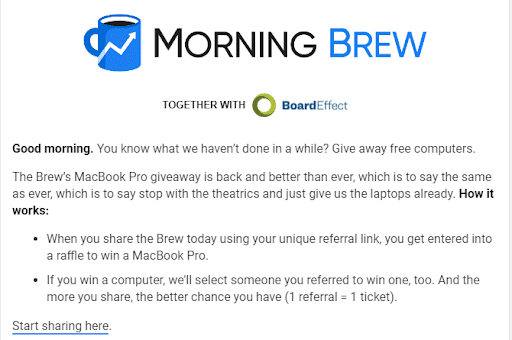
Thanks in large part to their referral marketing program, Morning Brew grew their reader base from 100,000 to 1.5 million subscribers in just 18 months. Today, around 30% of their over 2.5 million subscribers come from referrals. The Morning Brew referral program proves that even businesses that offer free content can build up their subscriber base through referrals – without breaking the bank.
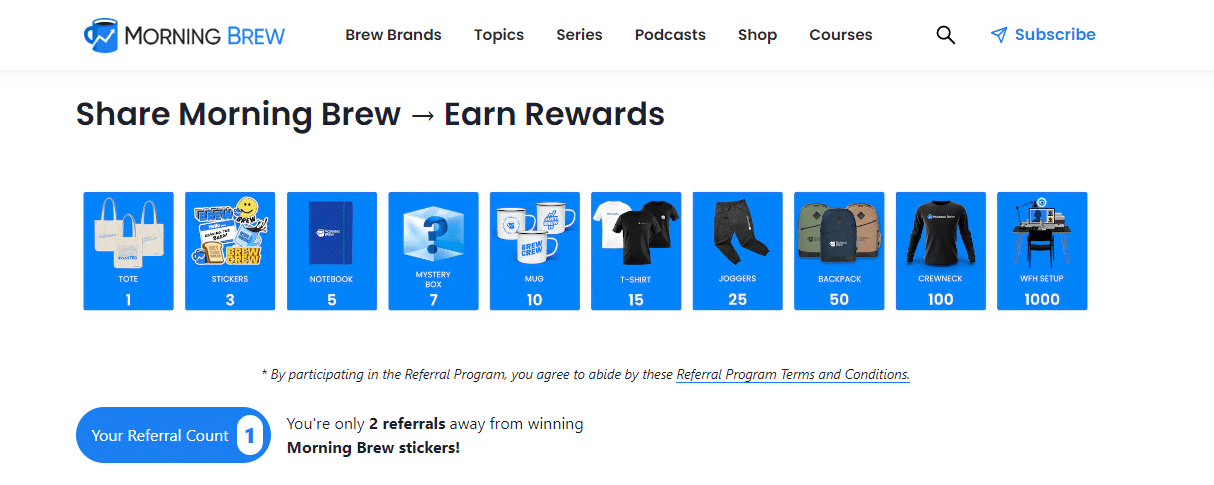
What can you learn from Morning Brew’s referral marketing?
- Swag works great as a cost-effective referral reward (and gives you free promotion when your customers wear or use it).
- A tiered structure, where customers can earn more valuable rewards as they make more referrals, effectively encourages repeat sharing.
- It helps if you make it easy to track how many referrals it takes to get to the next tier, like Morning Brew does with their counter.
- A big-ticket reward (the ultimate work-from-home makeover!) helps mobilize super-referrers. Even the most prolific referrals have a reward to keep working towards.
- It helps if you promote your referral marketing program frequently and naturally, like Morning Brew does.
- The brand uses their emails to their advantage, by promoting the program in every issue of their email newsletter.
- You can use this strategy even if you don’t have a newsletter – promote your program regularly in other emails, such as sale and announcement emails.
- Provide multiple options for customers to make referrals, including social media, email, and a unique referral link.
3. Harry’s
Razor company Harry’s used referral marketing to generate buzz before their official launch. Whenever website visitors gave their email to learn more about the brand, Harry’s directed them to a referral page where they could invite their friends to sign up for email updates as well. Once someone got enough friends to sign up, they earned free Harry’s products as rewards.
This referral marketing effort was a smashing success – in just a single week, Harry’s secured 85,000 valid email addresses of interested potential customers! Plus, the people who referred the most friends during prelaunch still remain some of the biggest advocates of Harry’s.
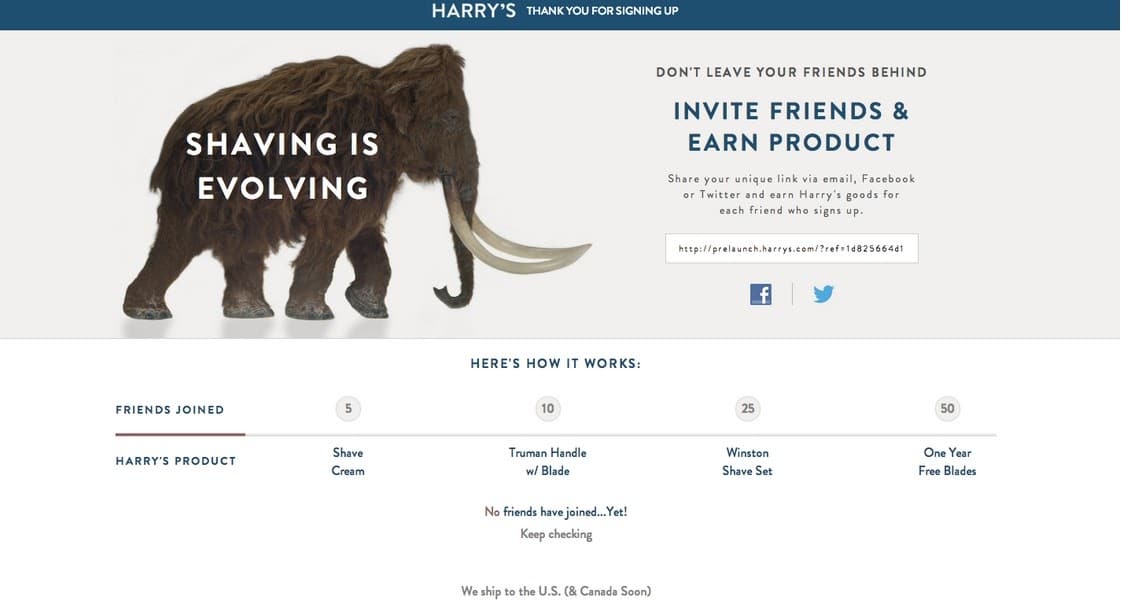
What can you learn from Harry’s referral marketing?
- People love being treated like insiders – and they also love letting friends in on insider information. So, creating a pre-launch referral experience is a great way to earn social currency.
- Invite people to refer while your brand is top-of-mind. For Harry’s, this invitation came right after people signed up for emails. For your brand, this likely means asking for referrals on your thank-you page, right after someone makes a purchase. The strategy works especially well if you offer free products, store credits, or discounts off of their next purchase.
- Consider encouraging people to help friends discover something new in your messaging, like Harry’s did with the text “Don’t leave your friends behind.”
- Try offering new products as referral rewards. Customers will love being the first to try them, especially for free.
- A tiered structure, where customers can earn more valuable rewards as they make more referrals, effectively encourages repeat sharing.
- Keep your program description simple on the referral program page, so it’s easy for customers to understand the program and start sharing. Make sure it’s easy to tell what rewards are available.
- Provide multiple options for customers to make referrals, including social media, email, and a unique referral link.
Is your business ready to try referral marketing?
As we’ve shown above, referral marketing can work well for businesses in any industry, whether you run an ecommerce business, a B2B, a SaaS company, a subscription service, or even a bank. Of course, not every business is ready for a referral marketing program. Here are some easy ways to tell whether your business is a good fit for a referral marketing strategy:
1. You have established social proof
Referrals are only effective if you have something worth referring in the first place. This means you have positive customer reviews, glowing testimonials, organic word of mouth, and other forms of recognition. By showing that your existing customers love you, you’re using the power of social proof to encourage others to try you too.
2. You offer a great product and strong customer service
It makes sense: If you don’t offer something that solves a problem or meets a need, or if your product is poorly made, you won’t get good word of mouth.
The same goes for your customer service – you’ll need to offer a top-notch customer experience before people will recommend you.
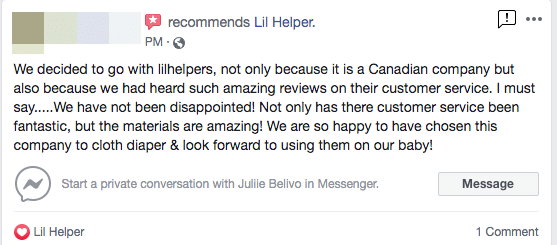
No matter how great the incentive, your referral marketing plan will have a hard time scaling in the long run if people realize your product, or your customer experience, doesn’t meet their expectations.
3. You have a base of loyal customers
Referral marketing starts with your most loyal customers, fans, and brand ambassadors. Since they already use and love your products, they are the most likely to refer others (maybe they do this already!). Plus, the rewards that are baked into referral programs are a great way to show your appreciation for their support.
4. There’s a good reason for consumers to refer you
No, we’re not talking about rewards, although that definitely helps. Aside from offering incentives, your brand should also offer something of significant value.
- Products that do something groundbreaking or unexpected, or that accomplish a task significantly better than competitors, generate the most buzz.
- A compelling product story or brand story, such as why a product was created or the journeys and challenges involved in development, might also establish your brand as valuable (like how Browndages was the first to create bandages that blend in with darker skin tones).
- And if you offer a unique experience that people already can’t help but share? Even better.
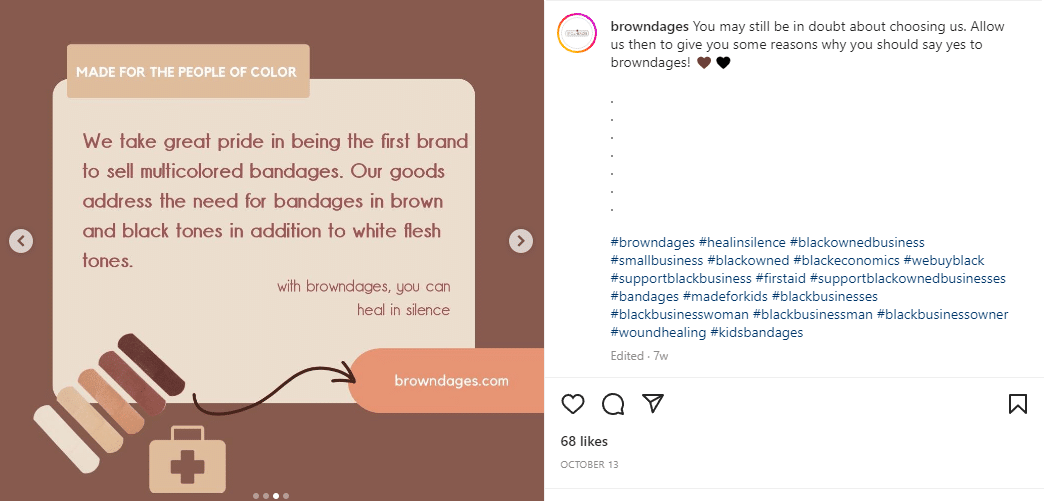
Setting expectations in referral marketing
After putting time and thought into a referral marketing strategy, it’s only natural to want immediate results. While everyone wants their campaign to go viral like the examples we’ve shared, it’s also important to be realistic.
1. Don’t expect to go viral
You may not have the next Dropbox referral program on your hands – and that’s okay! Your program can still be successful. Don’t let the referral numbers of other programs throw your expectations.
Instead, focus on providing a standout product and a memorable customer and referral experience, and sales will naturally flow in.
2. Don’t assume customers are always thinking about you
Even the best-laid referral marketing plan still needs constant promotion.
Just because a customer likes you doesn’t mean they talk about you (or even think about you) on a regular basis. This is why you need to promote your program.
Even your most loyal customers are busy with other things, and sending them a friendly referral email or message can be the reminder they need to refer others.
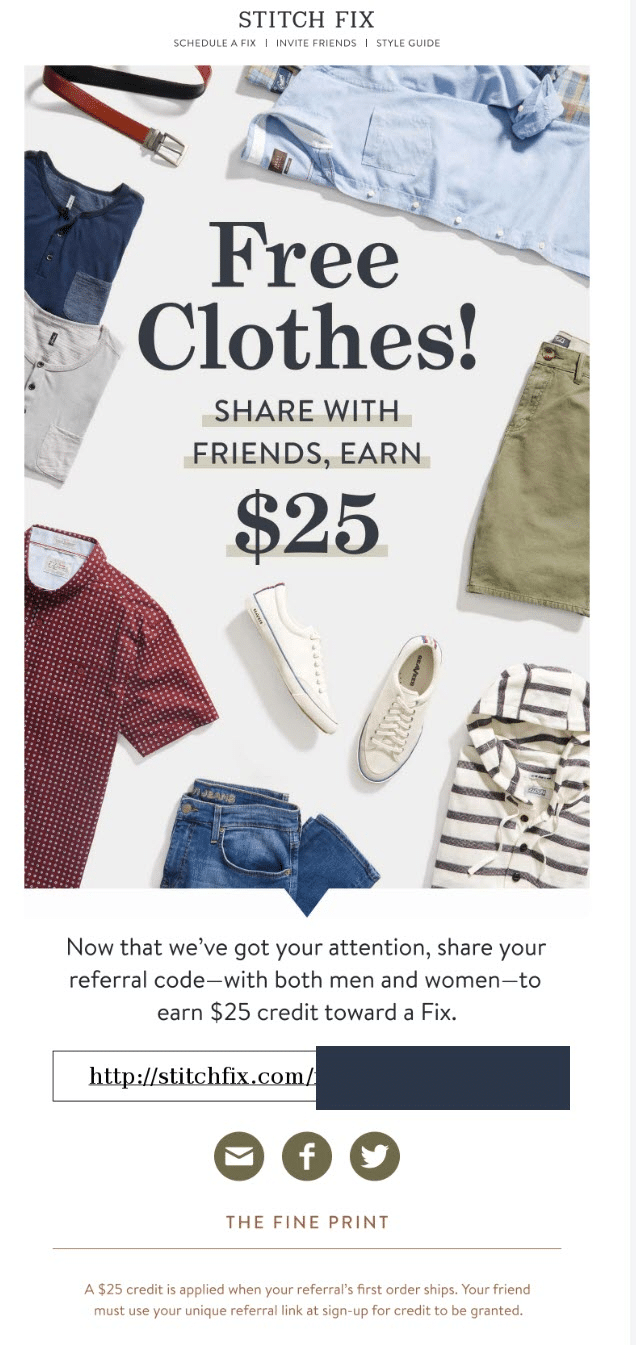
3. Don’t expect the program to run itself
Yes, you can automate your entire referral process, from creating referral codes for customers to issuing rewards. You can even set certain triggers to promote your program. But you still have to do a little work if you want your referral marketing plan to be a success.
You need to occasionally check that your program is still running smoothly, and tweak rewards and promotion strategies if things aren’t going as expected.
If you decide to run a DIY referral marketing program, you’ll have to be even more hands on. It’s important to align referrals to your core business, check for any referral fraud (i.e., self-referrals, duplicate referrals), and make sure you keep track of every referral and reward customers right away.
4. Don’t expect a constant level of engagement
After launching your referral program, you might get a surge of new leads. Congratulations!
In time, however, the number of referrals may mellow out. This is normal. Just like slow sales months, you’ll also have slow referral months.
This is the perfect time to do a little pruning and testing in some areas of your referral marketing program. For example, try offering another type of reward, or promoting your program through other channels. Take note of any changes and see what works best for your business.
Start your referral marketing program
It’s time to start getting more referrals!
The big question is: Will you build a program in-house or use referral software to get up and running? If you have the time, patience, and ability to build your own referral marketing program, then go for it. But be warned: the management and tracking tasks involved can quickly cause headaches once referrals start rolling in.
If you’d rather leave the heavy lifting and any development tasks off your plate, software might be the answer. Referral software (like Referral Rock!) handles everything from referral tracking and program promotion to analytics and reporting, creating a smooth referral experience for everyone involved. Plus, it allows you start getting referrals to your business right away. Here’s what a few of our customers have to say:
“Referral Rock has helped us grow our referral customer base by leaps and bounds. It’s easy to use and set up, and the team guides you through the process and is there to support you along the way.” – Stacie, Admin Manager, Home Services
“Fantastic product! We received excellent customer service from sales to implementation, at a lower cost than competitors. The customizable tools and portal are extremely easy to use.” – Nicole, Marketing Supervisor, Banking
“The flexibility and customization options make the platform incredibly valuable. We’re able to merge our customer experience with [Referral Rock’s] underlying technology seamlessly.” Austin, Growth Manager, Consumer Goods
Remember: By automating your referral marketing, you’ll be able to compound your existing sales and marketing efforts instead of trying to add more work on for your team. Book a demo to learn more!




